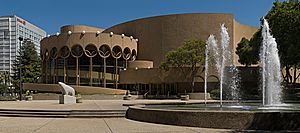American Musical Theatre of San Jose facts for kids

The American Musical Theatre of San Jose (AMTSJ) was a big professional musical theatre group in San Jose, California. It was also known as the San Jose Civic Light Opera (SJCLO). Started in 1934, it grew to be one of the largest theatre companies in Northern California. They had a budget of $9.8 million each year. Over 150,000 people came to their shows, and 15,000 people bought season tickets. The company performed at the San Jose Center for the Performing Arts, which has 2,677 seats. AMTSJ faced money problems after 2002 and closed down in December 2008.
Contents
History of the Theatre Group
The American Musical Theatre of San Jose changed its name several times over the years.
San Jose Light Opera Association
In 1934, a group of local volunteers started the San Jose Light Opera Association (SJLOA). They performed "light operas," which are like happy, fun operas. Their first show was The Mikado. They performed at different places in downtown San Jose, like the Victory Theatre and the Montgomery Theatre.
Around 1957, SJLOA started performing musical theatre instead of just light opera. Musical theatre is like a play where people sing and dance a lot. They also moved their shows to the San Jose Civic Auditorium. Their first musical theatre productions there were Carousel and Guys and Dolls.
San Jose Music Theatre
In 1972, the group became more popular and changed its name to San Jose Music Theatre (SJMT). They planned to move to the new San Jose Community Theatre. This theatre was later renamed the San Jose Center for the Performing Arts. For this move, SJMT hired its first professional actor from Equity. This was Enzo Stuarti, for their show South Pacific. But the theatre's ceiling fell, so the move was delayed for three years.
In 1975, SJMT finally performed at the Center for Performing Arts with Guys and Dolls. That same year, they started hiring many more professional actors. These included famous stars like Michele Lee and Tommy Tune. Because of all these professional actors, SJMT had to start making costumes for everyone. Before that, actors made their own costumes. By 1979, SJMT made costumes for the whole cast.
The 1979-1980 season was tough for the company. A new show called City of Broken Promises cost too much money. SJMT almost went out of business. The president of the board quit. The new president asked each board member to give $500 or leave. They all gave the money. This, plus a grant from Chevron, saved the company from financial trouble.
San Jose Civic Light Opera
After the tough 1979-1980 season, the board hired Stewart Slater as General Manager. This started a new time for the company, and they changed their name again to San Jose Civic Light Opera (SJCLO). Slater had worked for another big theatre group in San Francisco. He was good at business. Within two years, SJCLO had enough money and made a profit for eight years in a row.
When Slater took over, the company often hired famous actors to attract audiences. But this meant less money for the rest of the show. Many other actors were volunteers and not paid. Slater stopped this. He focused on making the whole show great, not just paying for big stars.
In 1984, SJCLO had extra money from ticket sales. Slater took a big chance. He hired a publicist to send out a huge amount of mail to people. This was the biggest mailing campaign ever for an arts group. He spent all the extra money on it. The risk worked! The number of season ticket buyers grew by 10,000 in just two years.
Under Slater, the company's reputation and audience grew steadily. Shows like Jesus Christ Superstar in 1989 and Chess in 1991 were very successful. Dianna Shuster, who Slater made Artistic Director in 1985, thought these were great achievements.
American Musical Theatre of San Jose
In 1995, the theatre changed its name one last time to American Musical Theatre of San Jose. This was to celebrate its 60th birthday.
In 2002, AMTSJ made a deal with the Nederlander Organization. This is a very large company that runs theatres in the United States. The deal meant AMTSJ could bring in big touring Broadway shows. They would also still produce their own local shows. This ended 67 years of only producing their own shows. The artistic director, Dianna Shuster, left because of this change.
After the Nederlander deal, fewer people bought single tickets or season tickets. Donations also went down a lot. The company lost at least $2 million in two years. Stewart Slater, who had been there for 24 years, left. The new executive producer, Michael Miller, said the problems happened because the local community felt disconnected. They felt local talent was pushed aside. The economy in Silicon Valley was also struggling.
Michael Miller came from another theatre group in New Jersey. He started a plan to get more money. He offered flexible ticket packages, did a lot of marketing, and worked hard to raise money. His plan worked quickly. In 2005, AMTSJ made over $500,000 in profit. This helped them cut their debt by one-third.
Bankruptcy and Closure
On November 26, 2008, AMTSJ let go of all its employees. The next week, the company officially closed down. They filed for Chapter 7 bankruptcy. Executive producer Michael Miller said the sudden failure was because of a $1.7 million loss. This loss came from a musical called Tarzan, which they produced with another company in Atlanta. Miller said they might take legal action against the other company. He claimed money given for Tarzan was used for other things. The company's belongings were sold off in February 2009.

